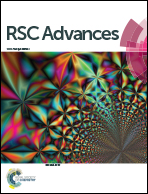Aryldihydronaphthalene-type lignans from Bursera fagaroides var. fagaroides and their antimitotic mechanism of action†
Abstract
Three new aryldihydronaphthalene-type lignans, namely, 7′,8′-dehydropodophyllotoxin (1); 7′,8′-dehydro acetylpodophyllotoxin (2); and 7′,8′-dehydro trans-p-cumaroylpodophyllotoxin (3), were isolated from the stem bark of Bursera fagaroides var. fagaroides (Burseraceae), together with six known lignans, podophyllotoxin (4), acetylpodophyllotoxin (5), 5′-desmethoxy-β-peltatin A methylether (6), acetylpicropodophyllotoxin (7), burseranin (8), and hinokinin (9). The coumarin scopoletin (10) was also isolated from this bark. The chemical structure of all these compounds was determined by spectroscopic analyses including 2D NMR. We demonstrated that compounds 1–3 show different degrees of cytotoxic activity against human nasopharyngeal (KB), colon (HF-6), breast (MCF-7) and prostate (PC-3) cancer cell lines, with IC50 values ranging from 1.49 to 1.0 × 10−5 μM. In vivo studies of the effect of these natural lignans on the cell cycle, cell migration and microtubule cytoskeleton of developing zebrafish embryos, demonstrated their antimitotic molecular activity by disturbing tubulin. This is the first report on the occurrence of aryldihydronaphthalene lignans in the genus Bursera of the Burseraceae family, as well as on the determination of their cytotoxic activity and mechanism of action.



 Please wait while we load your content...
Please wait while we load your content...